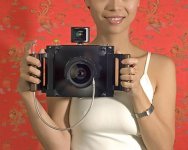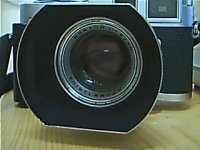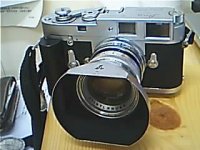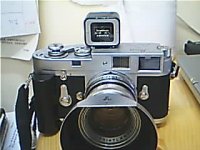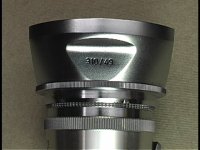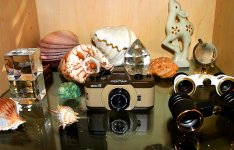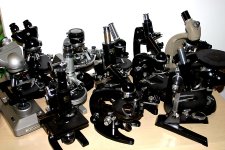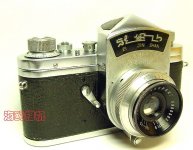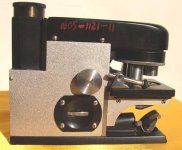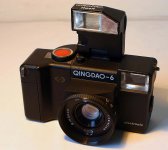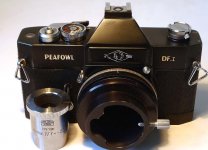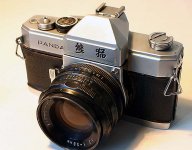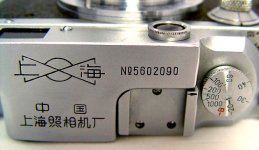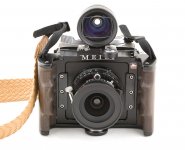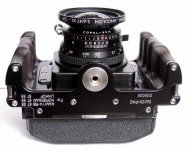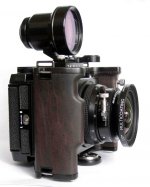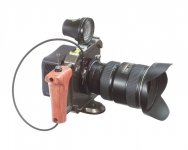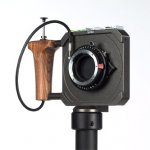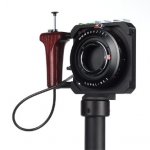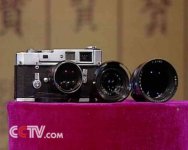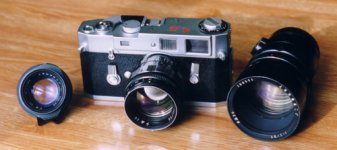You are using an out of date browser. It may not display this or other websites correctly.
You should upgrade or use an alternative browser.
You should upgrade or use an alternative browser.
Chinese Red Flag 20 and lenses
- Thread starter zhang xk
- Start date
- Latest activity Latest activity:
- Replies 637
- Views 117K
rbiemer
Unabashed Amateur
Gentlemen,zhang xk said:Will, many people are viewing this thread. These unknown Chinese optical products are very interesting.
Yes we are! This is awonderful thread you two are making! The cameras are fascinating. Thank you very much for sharing these with the rest of us.
Rob
Will
Well-known
Zhang,
Got lucky tonight and found a Voigtlander Prominent 310/47 hood for my silver ring Norton (1951, by serial number) in Hong Kong.
It's impossible to found online, try search this in yahoo.com.... 🙂
Swapped an older 310/49 for it, which are for later black ring norton, ultron etc.
(sorry about the webcam photo)
Got lucky tonight and found a Voigtlander Prominent 310/47 hood for my silver ring Norton (1951, by serial number) in Hong Kong.
It's impossible to found online, try search this in yahoo.com.... 🙂
Swapped an older 310/49 for it, which are for later black ring norton, ultron etc.
(sorry about the webcam photo)
Attachments
Will
Well-known
zhang xk
Well-known
Will said:Zhang,
Got lucky tonight and found a Voigtlander Prominent 310/47 hood for my silver ring Norton (1951, by serial number) in Hong Kong.
It's impossible to found online, try search this in yahoo.com.... 🙂
Swapped an older 310/49 for it, which are for later black ring norton, ultron etc.
(sorry about the webcam photo)
Congratulations! I know some weird lens hoods are very hard to find, and once found they could be very expensive. I don't know if there was a lens hood for my tracking lens, but the lens cap alone could be an expensive item.🙂
Will
Well-known
zhang xk said:Congratulations! I know some weird lens hoods are very hard to find, and once found they could be very expensive. I don't know if there was a lens hood for my tracking lens, but the lens cap alone could be an expensive item.🙂
Get a custom one done in BJ, China's labour for this kind of stuff is cheapest in the world...
With a 3000mm FL, the FOV is so small, I assume you can just but any tube in front of it as a lens hood.
Next I am gonna get one for my Alpa.
Also, I located three for Contax RF standards, but I already got a chinese 40.5 hood for it...
Any new toys?
zhang xk
Well-known
Will said:Also, I located three for Contax RF standards, but I already got a chinese 40.5 hood for it...
Any new toys?
I still have many toys. Cameras,watches, and microscopes,etc. I also collected some coins and sea shells. Usually, I do not touch those antiques and stones as most of them are fakes.
Attachments
zhang xk
Well-known
Here is a clear image of the rare Chinese Zijinshan. A copy of the Russian Zenit 135 SLR. Less than 1,000 cameras were made, and a better example demands RMB 8,000 or more.
Also an image of a Chinese mini microscope for military use on battle fields.
Also an image of a Chinese mini microscope for military use on battle fields.
Attachments
zhang xk
Well-known
rxmd
May contain traces of nut
It looks like the Agfa Optima Flash Electronic. That's a nice little camera. Unfortunately it's based on the Agfa Optima 1035, not its big sister 1535 which would have had a rangefinder (and is BTW quite an excellent camera).
Did Agfa actually have these assembled in China or is it a copy?
Philipp
Did Agfa actually have these assembled in China or is it a copy?
Philipp
zhang xk
Well-known
rxmd said:......
Did Agfa actually have these assembled in China or is it a copy?
Philipp
I think earlier cameras were Agfa assembled in China, and later ones were Chinese cameras with local parts.
zhang xk
Well-known
A black Peafowl with a microscope adaptor. These were called "black diamonds" by users in some foreign countries. It is built like a tank. The 58/2 Zeiss Biotar copy normal lens is very sharp.🙂
Early version was called Panda that is an uncommon camera with provision for a motor, DOF preview, flash contacts for X, FP, and mirror lock-up.
Early version was called Panda that is an uncommon camera with provision for a motor, DOF preview, flash contacts for X, FP, and mirror lock-up.
Attachments
zhang xk
Well-known
Will
Well-known
zhang xk said:A Shanghai 58-2 with a wrong S/N. All Shanghai rangefinder cameras with a S/N that starts with 58XXXXX. Only some 1,100 Shanghai 58-1s were made. This camera looks more like a Leica III F. However, some 58-1s has no strap lugs.
This is a lucky found, sure it will be come very valuable one day.
Well done.
Will
Well-known
http://www.rangefinderforum.com/forums/attachment.php?attachmentid=32157&d=1157013543
Zhang,
You better go to New Zealand or Indonesia.
In the northern part of the North Island , New Zealand; which is almost tropical, you can find giant sea shells (10~16inch) for very little $.
Dad likes them, and we have about a dozen, brough in 1992~93. They took like a hundred years to grow.
It's a good way to remind yourself how power nature is...
Zhang,
You better go to New Zealand or Indonesia.
In the northern part of the North Island , New Zealand; which is almost tropical, you can find giant sea shells (10~16inch) for very little $.
Dad likes them, and we have about a dozen, brough in 1992~93. They took like a hundred years to grow.
It's a good way to remind yourself how power nature is...
Will
Well-known
zhang xk said:A black Peafowl with a microscope adaptor. These were called "black diamonds" by users in some foreign countries. It is built like a tank. The 58/2 Zeiss Biotar copy normal lens is very sharp.🙂
Early version was called Panda that is an uncommon camera with provision for a motor, DOF preview, flash contacts for X, FP, and mirror lock-up.
Which era is this, Zhang?
Will
Well-known
Will
Well-known
Will
Well-known
Zhang,
Any experience with that MeiLi camera in BJ?
Any experience with that MeiLi camera in BJ?
photocrazy
Established
The Red Flag 20 is actually a copy of Leica M3 and M4, and possibly the only one in the world. Mao's wife, Madam Jiang was very keen on photography. She worked as an actress in Shanghai in 1930s and had several affairs with some stars of that period. During the Cultural Revolution, Madam Jiang's role was mainly to control the arts movement for the campaign's propaganda. Being loyal to Mao, she took a quite number of Mao's portraits and published them under different pseudo-names. When the then Iranian king visited China, Madam Jiang was presented with Leica M3 as gift which she adored immensely. In 1970s, production of sophisticated cameras was regarded as a symbol of a country's industrial strength, particularly for developing nations. And also in the 1960s and 70s, China was pursuing an economic policy of absolute self-reliance and attempted to produce anything it needed. Against this background, Madam Jiang ordered the copy production of Leica M3 and gave her M3 to Shanghai Camera Factory to dissemble. The copy production of Leica M3 was a huge challenge to China's manufacturing industry. Every parts of the original M3 were measured and then hand-copied. Many institutes, universities and research centres were involved in the process and special glasses were imported from East Germany. The first batch of Red Flag 20 kit came out in 1973 with three lenses, 35mm f1.4, 50mm f1.4, 90mm f2, exact copies of Summilux and Summicron. But the Shanghai Camera Factory also made some modifications, including the back-door film loading mechanism. However, the production cost was unsustainably high. So only a total of 187 cameras rolled off the production line. The quality of the Red Flag 20 is said to be a long way behind Leica but is of great collection value due to its rarity and special history.
Attachments
Similar threads
- Article
- Replies
- 41
- Views
- 5K
- Article
- Replies
- 45
- Views
- 7K
- Replies
- 10
- Views
- 1K
- Article
- Replies
- 37
- Views
- 16K


